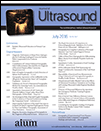Quantitative Cardiac Assessment in Fetal Tetralogy of Fallot
Abstract
Objectives
The purpose of this study was to quantitatively assess cardiac function and biometric parameters in fetuses with a diagnosis of tetralogy of Fallot and compare them to those in healthy fetuses.
Methods
Two hundred healthy fetuses and 20 fetuses with a diagnosis of classic tetralogy of Fallot were quantitatively assessed for 16 cardiac parameters, including morphologic characteristics and functions. All recruited fetuses were in the second trimester with correct gestational ages. The measured values that were out of normal reference ranges were considered abnormal. Rates of abnormalities of these parameters were compared between the groups. The significant parameters were further analyzed for their sensitivity, specificity, and likelihood ratio.
Results
Of the 16 parameters, rates of abnormalities in 7 parameters, including right ventricular wall thickness, peak systolic velocities (PSVs) in the pulmonary artery and aorta, time to peak velocity, or acceleration time, in the pulmonary artery, aortic valve diameter, pulmonary valve diameter, and aortic-to-pulmonary valve diameter ratio, were significantly higher in fetuses with tetralogy of Fallot (P < .001). The pulmonary artery PSV, pulmonary artery time to peak velocity, aortic valve diameter, pulmonary valve diameter, and aortic-to-pulmonary valve diameter ratio had high sensitivities (80.0%, 75.0%, 90.0%, 90.0%, and 100.0%, respectively) and specificities (95.5%, 97.0%, 94.5%, 96.0%, and 84.5%).
Conclusions
In addition to a routine anatomic examination, quantitative assessment of fetal hemodynamics, especially an abnormally high PSV in the pulmonary artery, as well as a shortened acceleration time and abnormal valve size, might be very helpful for confirmation of the diagnosis in cases of suspected tetralogy of Fallot.




